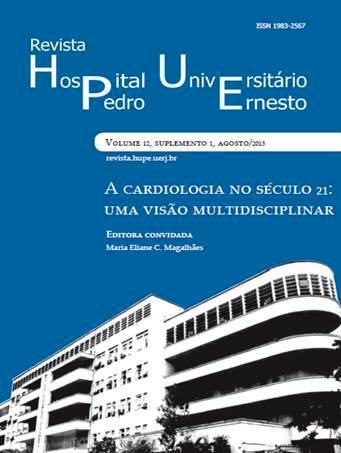Endocardite infecciosa: o que mudou na última década?
DOI:
https://doi.org/10.12957/rhupe.2013.7088Resumo
Revista HUPE, Rio de Janeiro, 2013;12(Supl 1):100-109
doi:10.12957/rhupe.2013.7088
A endocardite infecciosa (EI) é uma doença de alta morbidade e letalidade, apesar do avanço no diagnóstico clínico, do advento de novos tipos de antibióticos e do aperfeiçoamento de técnicas cirúrgicas. A padronização de critérios clínicos e laboratoriais de diagnóstico e a uniformização de condutas terapêuticas são estratégicas para melhorar o impacto da doença.Um achado importante na patogenia da EI é a lesão endotelial por turbulência do fluxo sanguíneo, seja o gerado por uma valva defeituosa (reumática, valva aórtica bicúspide, prótese valvar disfuncionante), ou por anomalia congênita (comunicação interventricular, cardiomiopatia hipertrófica obstrutiva, coarctação aórtica). A presença de dispositivos intracardíacos, como marcapassos e desfibriladores implantáveis, pode servir como suporte para a fixação de trombos e vegetações. Nas EIs são acometidas mais comumente as valvas mitral (40%) e aórtica (34%), seguida pelo acometimento de ambas. As infecções das valvas tricúspide e/ou pulmonar ocorrem mais em usuários de drogas endovenosas e como complicação relacionada à infecção de cateter vascular profundo. A valva pulmonar é raramente acometida. As vegetações são avascularizadas, tornando o tratamento difícil pelo baixo acesso dos antibióticos aos micro-organismos, o que exige tempo de tratamento prolongado e alta concentração sérica de antibióticos administrados por via parenteral.O ecocardiograma transtorácico (ETT) e o transesofágico (ETE) são de extrema importância para o diagnóstico, prognóstico, avaliação de complicações e para o seguimento dos pacientes com EI. Na presença de valvas degeneradas, calcificadas ou na presença de próteses mecânicas ou dispositivos intracardíacos, a utilização do ETE é de escolha para a visualização de vegetações. Propõem-se esquemas terapêuticos para as diferentes apresentações clínicas da endocardite, com base no agente etiológico provável e, quando possível, no agente isolado, utilizando‑se protocolos internacionais de tratamento e adaptando-os ao contexto brasileiro.
Descritores: Endocardite; Valvas cardíacas; Ecocardiografia; Antibacterianos.


